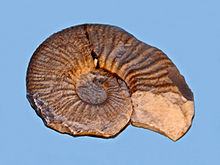Pseudothurmannia
Appearance
| Pseudothurmannia Temporal range: Cretaceous, [1]
| |
|---|---|

| |
| Fossil shells of Pseudothurmannia species from Alpes-de-Haute-Provence, on display at Galerie de paléontologie et d'anatomie comparée in Paris | |
| Scientific classification | |
| Kingdom: | |
| Phylum: | |
| Class: | |
| Subclass: | |
| Order: | |
| Superfamily: | |
| Family: | |
| Genus: | Pseudothurmannia Spath 1923
|
| Synonyms | |
| |
Pseudothurmannia is an extinct cephalopod genus belonging to the subclass Ammonoidea and included in the family Crioceratidae of the ammonitid superfamily Ancylocerataceae. These fast-moving nektonic carnivores [1] lived in the Cretaceous period, from Hauterivian age to Barremian age.[2]
Species
- Pseudothurmannia angulicostata d'Orbigny 1863
- Pseudothurmannia belimelensis Dimtrova 1967
- Pseudothurmannia grandis Busnardo 1970
- Pseudothurmannia jupiter Anderson 1938
- Pseudothurmannia mortilleti Pictet and de Loriol 1858
- Pseudothurmannia ohmi Winkler 1868
- Pseudothurmannia picteti Sarkar 1955
- Pseudothurmannia pseudomalbosi Sarasin and Schandelmayer 1901
- Pseudothurmannia renevieri Sarasin and Schöndelmayer 1901
- Pseudothurmannia russelli Anderson 1938
Description
Shell os Pseudothurmannia species can reach a diameter of about 4–12 centimetres (1.6–4.7 in). They show flat or slightly convex sides, a surface with dense ribs and a subquadrate whorl section.
Distribution
Fossils of species within this genus have been found in the Cretaceous rocks of Antarctica, Czechoslovakia, France, Hungary, Italy, Japan, Morocco, Spain, Russia and United States.[1]
References
- ^ a b c d The Paleobiology Database
- ^ Sepkoski, Jack Sepkoski's Online Genus Database – Cephalopoda
- Hoedemaeker, Philip. J. SEXUAL DIMORPHISM IN THE GENUS PSEUDOTHURMANNIA
- Crioceratites
